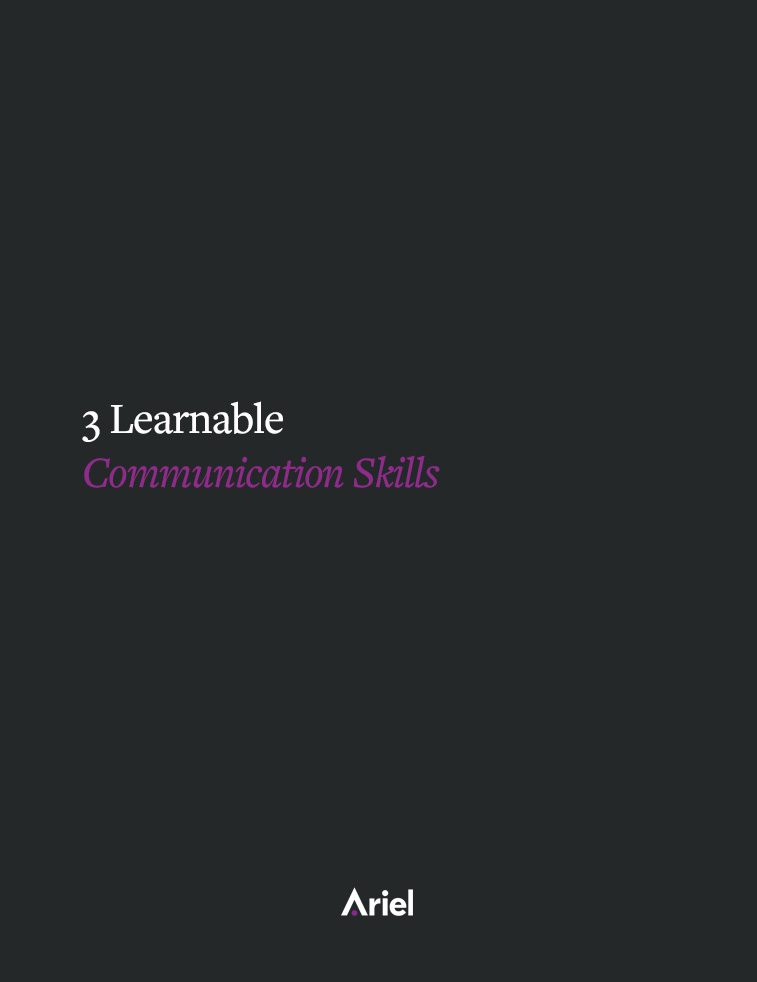Want to keep your best employees? Help them make a friend at work

What’s the number one factor in employee retention?
According to Hava Horowitz, communication expert and Ariel facilitator, it’s not salary, benefits, or even meaningful work–it’s having a friend at work.
We spend almost a third of our lives at work, so genuine connection with colleagues makes work more meaningful. Communication training builds these workplace connections by breaking down barriers that stop people from showing their whole selves at work.
How to Break Down Communication Barriers
Horowitz often facilitates communication workshops with groups that have known each other for years but don’t know key details about each other. She shares that they often say things like, “Wow, I didn’t know that you were born in Bolivia,” or “I had no idea what you were dealing with behind the scenes.”
These moments of connection change how teammates interact. People walk away feeling like their colleagues see them not just as a great leader or teammate but as a well-rounded human. It’s these moments of connection and community that make workplaces more likely to retain their employees.
Another part of connecting and bringing the “whole person” into work involves reflecting on our communication habits. Communication training helps single out habits that are no longer useful and habits that build understanding.
Expanding Communication Range Beyond “Expressive Habits”
We all develop communication patterns early in life–what communication expert Hava Horowitz calls “expressive habits.” These habits form in response to our life experiences (our cultural background, gender conditioning, and many other factors) and often stay with us long after they’ve served their purpose.
Horowitz gives the example, “I am under five feet tall, so I’ve learned that to be noticed, I have to be loud and take up a lot of space. It’s something I learned from a very early age—to be seen, I have to be really loud. That’s an expressive habit I’ve had to consciously try to unlearn and break.”
These expressive habits look different for everyone:
- Some people make themselves physically smaller to avoid attention
- Others use humor to defuse tense situations
- Some maintain a stern appearance to project authority
While these habits may have helped navigate childhood challenges, and often have value in adulthood, they may limit our potential as leaders to be responsive to changing circumstances. We need to pull out the right tool for job — not just use the same tool over and over again. The key isn’t to abandon these habits entirely but to expand our range beyond them.
A Different Communication Toolkit
The best leaders, the best communicators, aren’t the nicest or the sternest or the loudest or the quietest. They’re the ones with the most range.
– Hava Horowitz
Horowitz uses the analogy of a box of markers to illustrate our communication range. She explains, “Maybe I have a ‘make people laugh to defuse conflict’ marker. Or a ‘don’t smile so everybody knows I’m serious’ marker. And when you use a marker over and over and over again, it dries out.”
The same happens with communication styles. If you are always defusing conflict but not getting to the source of the conflict, your ‘defusing conflict’ marker runs out while your ‘solving conflict’ marker sits unused. Communication training allows people dust off unused markers by helping people:
- Recognize their default patterns and understand the ‘why’ behind them
- Learn when each communication style is most effective
- Adapt their style to different audiences and situations
Communication training equips people to be more versatile, to meet the needs of many different kinds of audiences, and to be responsive to many kinds of situations.
For organizations, communication training delivers:
- Improved employee retention. When people feel connected to their place of work, turnover falls.
- Greater team alignment. Leaders develop skills in bringing more clarity and confidence to their messaging, which inspires and galvanizes teams to meet the objectives that the leaders set out.
- Enhanced buy-in. Teams that feel inspired by their leader switch their mindset from ‘Oh, I have to do this because they told me’ to ‘I want to do this.’
For individuals, communication training helps develop:
- Increased confidence in expressing ideas and leading teams.
- Freedom to bring one’s whole self to work.
- Greater job satisfaction.
When we leave parts of ourselves behind at home and only show up with a sliver of who we are, it can feel restrictive and isolating. Horowitz’s answer to “How do we enjoy our work more?” is to create connections, authentically communicate with a range of communication styles, and stay present.
Effective Communication Training Builds Connection
Effective communication training isn’t about teaching people to speak or present in a standardized way. It’s about helping them discover their authentic voice while expanding their communication range and ability to connect with others.
As Horowitz tells participants: “Don’t pull anything out of your knapsack and leave it at home. Bring your entire backpack, bring your collection of yourself, bring your entire story.”
This approach to communication creates workplaces where people feel seen and valued for their whole selves, teams work together with greater understanding and trust, and leaders inspire genuine commitment rather than compliance.
As Horowitz puts it: “How liberating could it be to feel more skilled with communication, but also more authentic and more free.”
About Hava
Hava Horowitz is a Leadership Presence facilitator with the Ariel Group and an Executive Coach. She is dedicated to helping leaders, founders, and individuals enhance their presence, broaden their expressiveness, and speak in public fearlessly. Her unique background in entrepreneurship, stage performance, technology leadership, and mindfulness informs her dynamic approach.
Hava teaches regularly at Harvard Business School and works behind the scenes with leaders from Procter & Gamble, KPMG, Citi, Kaiser Permanente, the U.S. Military, and other major organizations worldwide. Her specialties include Public Speaking, Leadership Presence, Conflict Transformation, and Relationship Building. She is the co-founder and former CEO of Terraseed, the planet’s most sustainable supplement brand. Blazer off, she’s a performing artist and musician in the Boston-based group Sidebody and has studied acting for the last 15 years.
